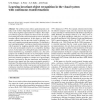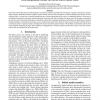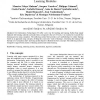728 search results - page 29 / 146 » Concept Maps and Learning Objects |
BC
2006
13 years 9 months ago
2006
Abstract The cerebral cortex utilizes spatiotemporal continuity in the world to help build invariant representations. In vision, these might be representations of objects. The temp...
ACL
2006
13 years 10 months ago
2006
Spoken language generation for dialogue systems requires a dictionary of mappings between semantic representations of concepts the system wants to express and realizations of thos...
LREC
2010
13 years 10 months ago
2010
One of the essential functions of natural language is to talk about spatial relationships between objects. Linguistic constructs can express highly complex, relational structures ...
INTERACT
2003
13 years 10 months ago
2003
: New Information Technologies (IT) offer a new way for teaching and learning. Rather than simply duplicate old learning materials and make them correspond to the new IT tools, it ...
WWW
2004
ACM
14 years 9 months ago
2004
ACM
The ontological representation of learning objects is a way to deal with the interoperability and reusability of learning objects (including metadata) through providing a semantic...



